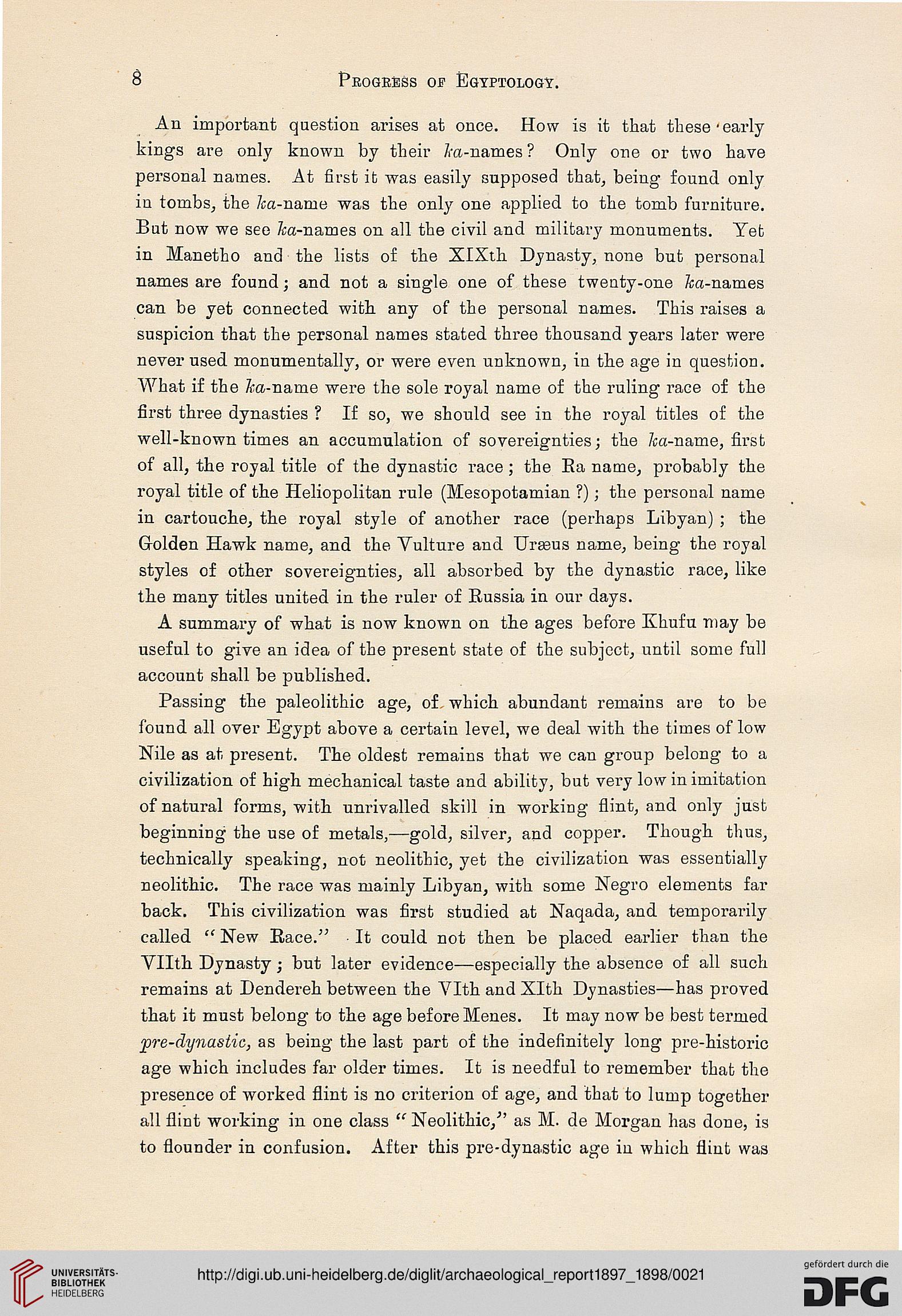8
Progress of Egyptology.
An important question arises at once. How is it that these'early
kings are only known by their /ra-names ? Only one or two have
personal names. At first it was easily supposed that, being found only
in tombs, the k-name was the only one applied to the tomb furniture.
But now we see Tea-names on all the civil and militai'y monuments. Yet
in Manetho and the lists of the XlXth Dynasty, none but personal
names are found; and not a single one of these twenty-one k-names
can be yet connected with any of the personal names. This raises a
suspicion that the personal names stated three thousand years later were
never used, monumentally, or were even unknown, in the age in question.
What if the /fa-name were the sole royal name of the ruling race of the
first three dynasties ? If so, we should see in the royal titles of the
well-known times an accumulation of sovereignties; the lea-name, first
of all, the royal title of the dynastic race ; the Ea name, probably the
royal title of the Heliopolitan rule (Mesopotamian ?); the personal name
in cartouche, the royal style of another race (perhaps Libyan) ; the
Golden Hawk name, and the Vulture and Uraeus name, being the royal
styles of other sovereignties, all absorbed, by the dynastic race, like
the many titles united in the ruler of Russia in our days.
A summary of what is now known on the ages before Khufu may be
useful to give an idea of the present state of the subject, until some full
account shall be published.
Passing the paleolithic age, of, which abundant remains are to be
found all over Egypt above a certain level, we deal with the times of low
Nile as at present. The oldest remains that we can group belong to a
civilization of high mechanical taste and ability, but very low in imitation
of natural forms, with unrivalled skill in working flint, and only just
beginning the use of metals,—gold, silver, and copper. Though thus,
technically speaking, not neolithic, yet the civilization was essentially
neolithic. The race was mainly Libyan, with some Negro elements far
back. This civilization was first studied at Naqada, and temporarily
called. " New Race." It could not then be placed earlier than the
Vllth Dynasty; but later evidence—especially the absence of all such
remains at Dendereh between the Vlth and Xlth Dynasties—has proved
that it must belong to the age before Menes. It may now be best termed
pre-dynastic, as being the last part of the indefinitely long pre-historic
age which includes far older times. It is needful to remember that the
presence of worked flint is no criterion of age, and that to lump together
all flint working in one class " Neolithic/' as M. de Morgan has done, is
to flounder in confusion. After this pre-dynastic age in which flint was
Progress of Egyptology.
An important question arises at once. How is it that these'early
kings are only known by their /ra-names ? Only one or two have
personal names. At first it was easily supposed that, being found only
in tombs, the k-name was the only one applied to the tomb furniture.
But now we see Tea-names on all the civil and militai'y monuments. Yet
in Manetho and the lists of the XlXth Dynasty, none but personal
names are found; and not a single one of these twenty-one k-names
can be yet connected with any of the personal names. This raises a
suspicion that the personal names stated three thousand years later were
never used, monumentally, or were even unknown, in the age in question.
What if the /fa-name were the sole royal name of the ruling race of the
first three dynasties ? If so, we should see in the royal titles of the
well-known times an accumulation of sovereignties; the lea-name, first
of all, the royal title of the dynastic race ; the Ea name, probably the
royal title of the Heliopolitan rule (Mesopotamian ?); the personal name
in cartouche, the royal style of another race (perhaps Libyan) ; the
Golden Hawk name, and the Vulture and Uraeus name, being the royal
styles of other sovereignties, all absorbed, by the dynastic race, like
the many titles united in the ruler of Russia in our days.
A summary of what is now known on the ages before Khufu may be
useful to give an idea of the present state of the subject, until some full
account shall be published.
Passing the paleolithic age, of, which abundant remains are to be
found all over Egypt above a certain level, we deal with the times of low
Nile as at present. The oldest remains that we can group belong to a
civilization of high mechanical taste and ability, but very low in imitation
of natural forms, with unrivalled skill in working flint, and only just
beginning the use of metals,—gold, silver, and copper. Though thus,
technically speaking, not neolithic, yet the civilization was essentially
neolithic. The race was mainly Libyan, with some Negro elements far
back. This civilization was first studied at Naqada, and temporarily
called. " New Race." It could not then be placed earlier than the
Vllth Dynasty; but later evidence—especially the absence of all such
remains at Dendereh between the Vlth and Xlth Dynasties—has proved
that it must belong to the age before Menes. It may now be best termed
pre-dynastic, as being the last part of the indefinitely long pre-historic
age which includes far older times. It is needful to remember that the
presence of worked flint is no criterion of age, and that to lump together
all flint working in one class " Neolithic/' as M. de Morgan has done, is
to flounder in confusion. After this pre-dynastic age in which flint was





